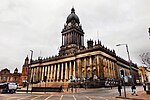St George's Church, Leeds
19th-century Church of England church buildingsAnglican Diocese of LeedsChurch of England church buildings in West YorkshireChurches completed in 1838Grade II listed churches in Leeds

St George's Church, Leeds is a Church of England parish church based in the centre of Leeds, West Yorkshire, England. The church building is near to Leeds General Infirmary. Although based in the city centre, the congregation is drawn from all parts of the city, including a large student congregation. The current staff team includes the rector Lizzy Woolf, associate rectors Eve Ridgeway and Adrian Smith, curate Julia Wilkins, and John Walker. Jon Swales leads the Lighthouse community.
Excerpt from the Wikipedia article St George's Church, Leeds (License: CC BY-SA 3.0, Authors, Images).St George's Church, Leeds
Thoresby Place, Leeds Woodhouse
Geographical coordinates (GPS) Address External links Nearby Places Show on map
Geographical coordinates (GPS)
| Latitude | Longitude |
|---|---|
| N 53.8015 ° | E -1.5532 ° |
Address
St George's Church
Thoresby Place
LS1 3BR Leeds, Woodhouse
England, United Kingdom
Open on Google Maps










